Abstract
Treatment with cyclophosphamide (Cy) before contact sensitization regularly intensifies the induced sensitivity. The immunopotentiation is specific and appears due to toxicity for suppressor cells. It has been proposed that the target of Cy immunopotentiation is a suppressor B cell. We have studies allergic contact dermatitis (ACD) in mice rendered B-cell deficient by chronic treatment, beginning at birth, with a goat antiserum against mouse IgM. The ACD induced in these B-cell deficient mice was equal to that induced in intact mice. The hypersensitivity was readily and equally immunopotentiated by Cy in normal and in B-cell deficient mice. It appears that the suppressor cell that is the target of Cy immunopotentiation is not a B cell but rather a T cell.
Full text
PDF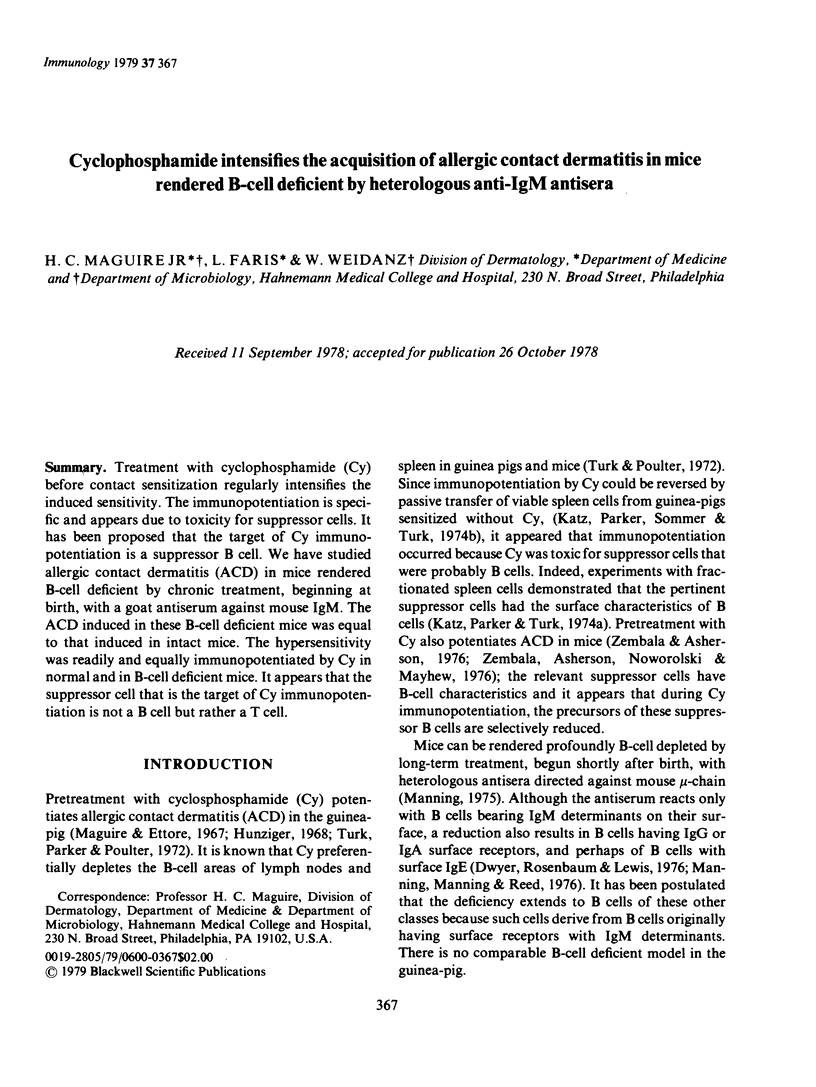
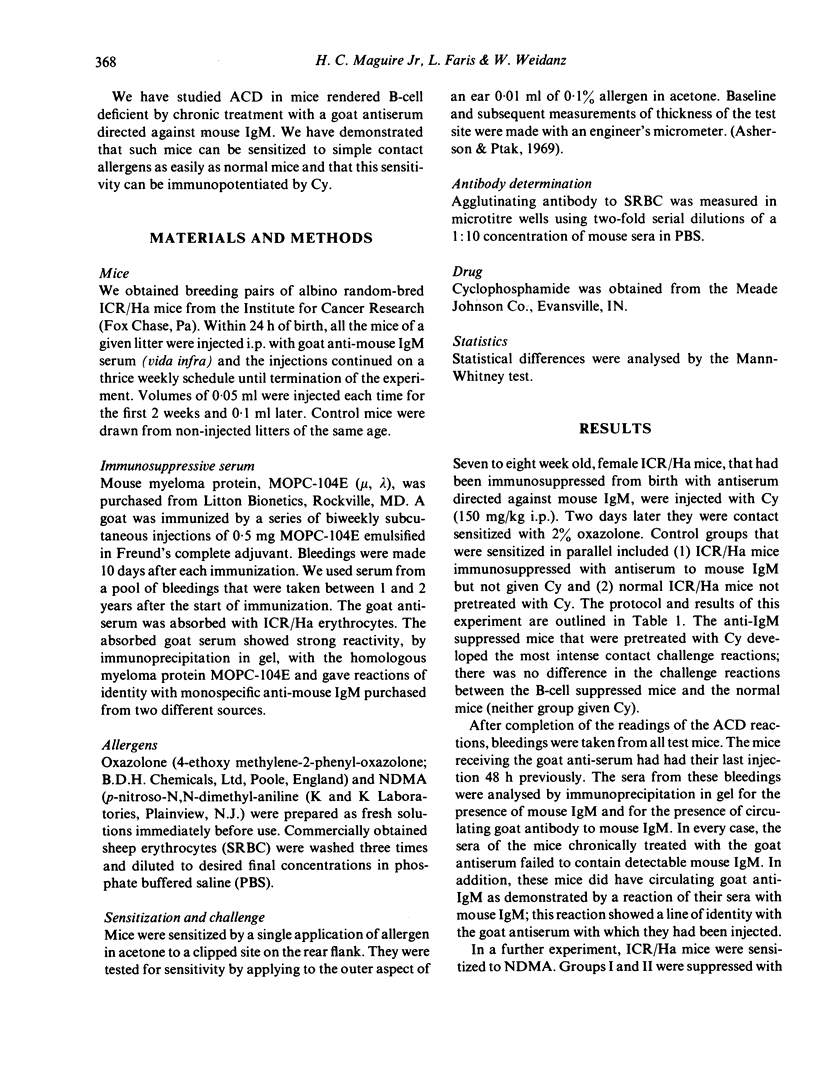
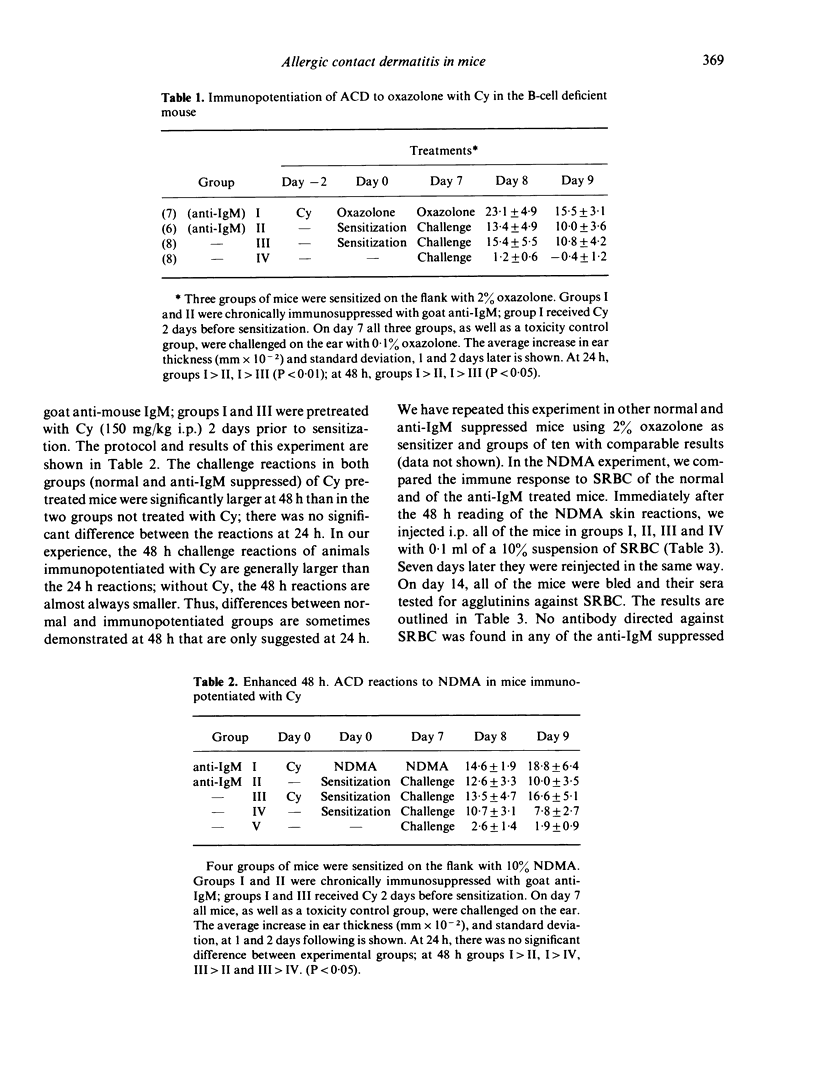
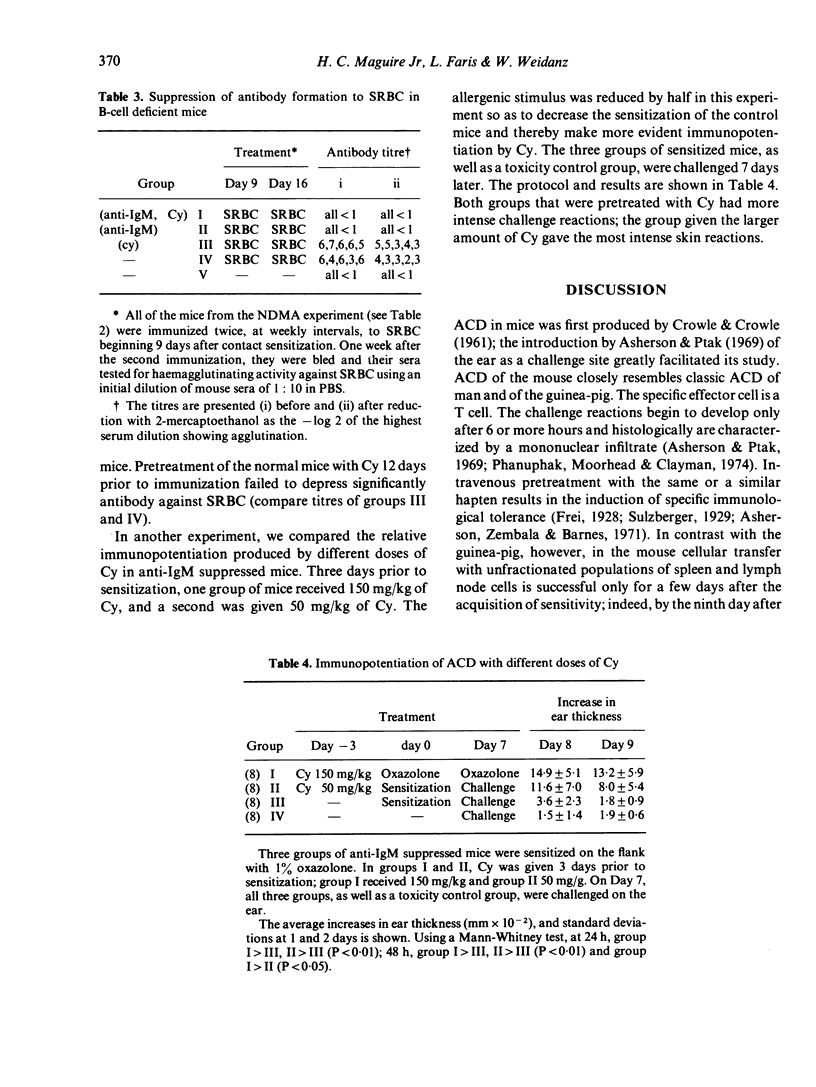
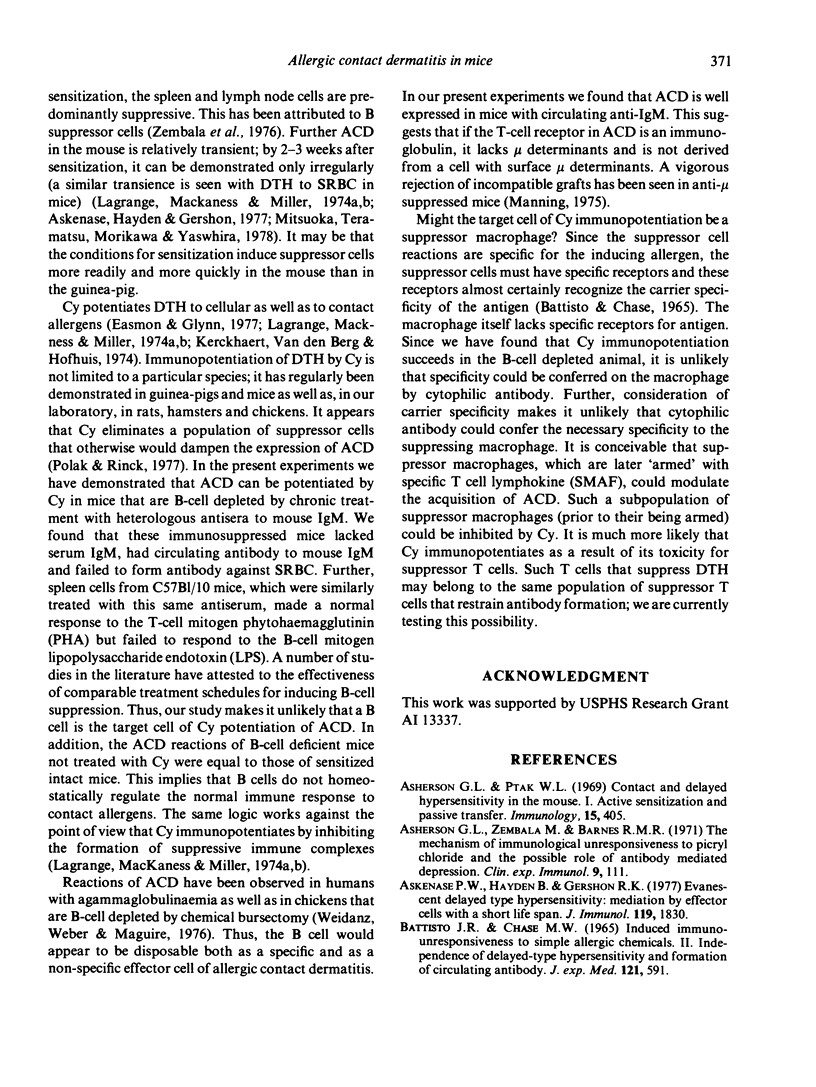
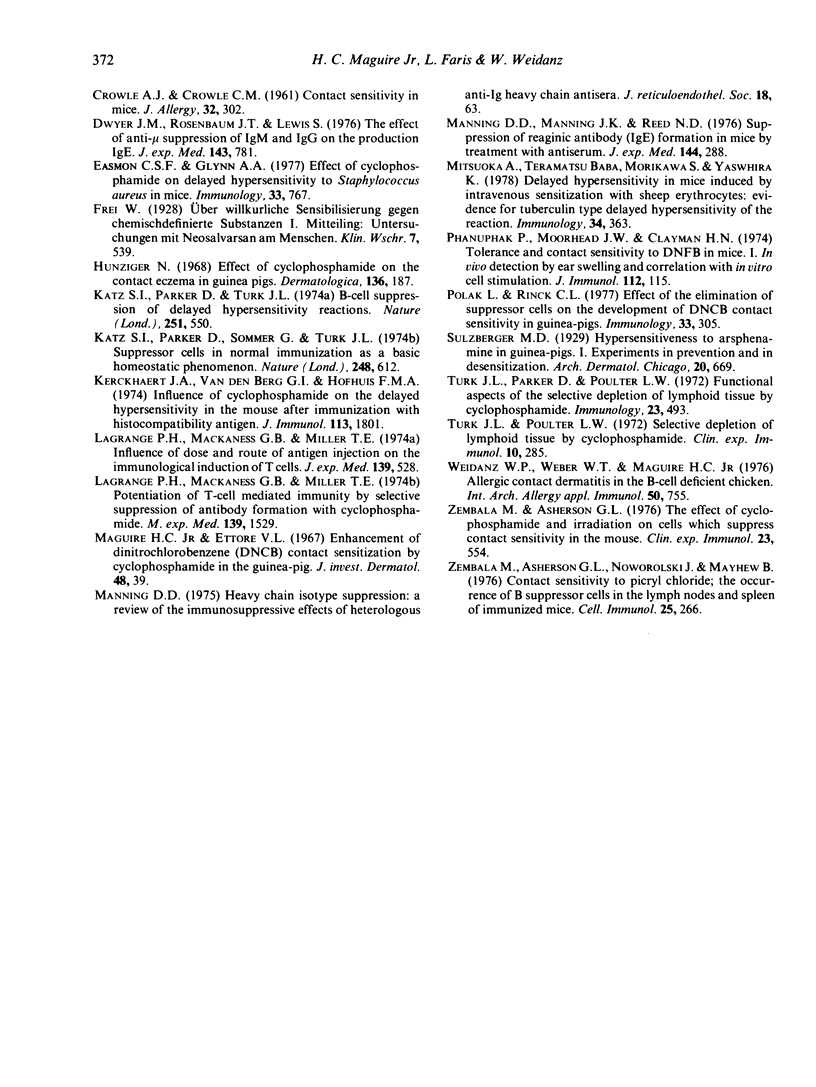
Selected References
These references are in PubMed. This may not be the complete list of references from this article.
- Asherson G. L., Ptak W. Contact and delayed hypersensitivity in the mouse. I. Active sensitization and passive transfer. Immunology. 1968 Sep;15(3):405–416. [PMC free article] [PubMed] [Google Scholar]
- Asherson G. L., Zembala M., Barnes R. M. The mechanism of immunological unresponsiveness to picryl chloride and the possible role of antibody mediated depression. Clin Exp Immunol. 1971 Jul;9(1):111–121. [PMC free article] [PubMed] [Google Scholar]
- Askenase P. W., Hayden B., Gershon R. K. Evanescent delayed-type hypersensitivity: mediation by effector cells with a short life span. J Immunol. 1977 Nov;119(5):1830–1835. [PubMed] [Google Scholar]
- BATTISTO J. R., CHASE M. W. INDUCED UNRESPONSIVENESS TO SIMPLE ALLERGENIC CHEMICALS. II. INDEPENDENCE OF DELAYED-TYPE HYPERSENSITIVITY AND FORMATION OF CIRCULATING ANTIBODY. J Exp Med. 1965 Apr 1;121:591–606. doi: 10.1084/jem.121.4.591. [DOI] [PMC free article] [PubMed] [Google Scholar]
- CROWLE A. J., CROWLE C. M. Contact sensitivity in mice. J Allergy. 1961 Jul-Aug;32:302–320. doi: 10.1016/0021-8707(61)90098-3. [DOI] [PubMed] [Google Scholar]
- Dwyer J. M., Rosenbaum J. T., Lewis S. The effect of anti-mu suppression of gammaM and gammaG on the production of gammaE. J Exp Med. 1976 Apr 1;143(4):781–790. doi: 10.1084/jem.143.4.781. [DOI] [PMC free article] [PubMed] [Google Scholar]
- Easmon C. S., Glynn A. A. Effect of cyclophosphamide on delayed hypersensitivity to Staphylococcus aureus in mice. Immunology. 1977 Nov;33(5):767–776. [PMC free article] [PubMed] [Google Scholar]
- Katz S. I., Parker D., Sommer G., Turk J. L. Suppressor cells in normal immunisation as a basic homeostatic phenomenon. Nature. 1974 Apr 12;248(449):612–614. doi: 10.1038/248612a0. [DOI] [PubMed] [Google Scholar]
- Katz S. I., Parker D., Turk J. L. B-cell suppression of delayed hypersensitivity reactions. Nature. 1974 Oct 11;251(5475):550–551. doi: 10.1038/251550a0. [DOI] [PubMed] [Google Scholar]
- Kerckhaert J. A., van den Berg G. J., Hofhuis F. M. Influence of cyclophosphamide on the delayed hypersensitivity in the mouse after immunization with histocompatibility antigen. J Immunol. 1974 Dec;113(6):1801–1806. [PubMed] [Google Scholar]
- Lagrange P. H., Mackaness G. B., Miller T. E. Influence of dose and route of antigen injection on the immunological induction of T cells. J Exp Med. 1974 Mar 1;139(3):528–542. doi: 10.1084/jem.139.3.528. [DOI] [PMC free article] [PubMed] [Google Scholar]
- Lagrange P. H., Mackaness G. B., Miller T. E. Potentiation of T-cell-mediated immunity by selective suppression of antibody formation with cyclophosphamide. J Exp Med. 1974 Jun 1;139(6):1529–1539. doi: 10.1084/jem.139.6.1529. [DOI] [PMC free article] [PubMed] [Google Scholar]
- Maguire H. C., Jr, Ettore V. L. Enhancement of dinitrochlorobenzene (DNCB) contact sensitization by cyclophosphamide in the guinea pig. J Invest Dermatol. 1967 Jan;48(1):39–43. doi: 10.1038/jid.1967.6. [DOI] [PubMed] [Google Scholar]
- Manning D. D. Heavy chain isotype suppression: a review of the immunosuppressive effects of heterologous anti-Ig heavy chain antisera. J Reticuloendothel Soc. 1975 Jul;18(1):63–86. [PubMed] [Google Scholar]
- Manning D. D., Manning J. K., Reed N. D. Suppression of reaginic antibody (IgE) formation in mice by treatment with anti-mu antiserum. J Exp Med. 1976 Jul 1;144(1):288–292. doi: 10.1084/jem.144.1.288. [DOI] [PMC free article] [PubMed] [Google Scholar]
- Mitsuoka A., Teramatsu T., Baba M., Morikawa S., Yasuhira K. Delayed hypersensitivity in mice induced by intravenous sensitization with sheep erythrocytes: evidence for tuberculin type delayed hypersensitivity of the reaction. Immunology. 1978 Mar;34(3):363–370. [PMC free article] [PubMed] [Google Scholar]
- Phanuphak P., Moorhead J. W., Claman H. N. Tolerance and contact sensitivity to DNFB in mice. I. In vivo detection by ear swelling and correlation with in vitro cell stimulation. J Immunol. 1974 Jan;112(1):115–123. [PubMed] [Google Scholar]
- Polak L., Rinck C. Effect of the elimination of suppressor cells on the development of DNCB contact sensitivity in guinea-pig. Immunology. 1977 Sep;33(3):305–311. [PMC free article] [PubMed] [Google Scholar]
- Turk J. L., Parker D., Poulter L. W. Functional aspects of the selective depletion of lymphoid tissue by cyclophosphamide. Immunology. 1972 Oct;23(4):493–501. [PMC free article] [PubMed] [Google Scholar]
- Turk J. L., Poulter L. W. Selective depletion of lymphoid tissue by cyclophosphamide. Clin Exp Immunol. 1972 Feb;10(2):285–296. [PMC free article] [PubMed] [Google Scholar]
- Weidanz W. P., Weber W. T., Maguire H. C., Jr Allergic contact dermatitis in the B-cell deficient chicken. Int Arch Allergy Appl Immunol. 1976;50(6):755–758. doi: 10.1159/000231554. [DOI] [PubMed] [Google Scholar]
- Zembala M., Asherson G. L., Noworolski J., Mayhew B. Contact sensitivity to picryl chloride: the occurrence of B suppressor cells in the lymph nodes and spleen of immunized mice. Cell Immunol. 1976 Aug;25(2):266–278. doi: 10.1016/0008-8749(76)90117-9. [DOI] [PubMed] [Google Scholar]
- Zembala M., Asherson G. L. The effect of cyclophosphamide and irradiation on cells which suppress contact sensitivity in the mouse. Clin Exp Immunol. 1976 Mar;23(3):554–561. [PMC free article] [PubMed] [Google Scholar]


